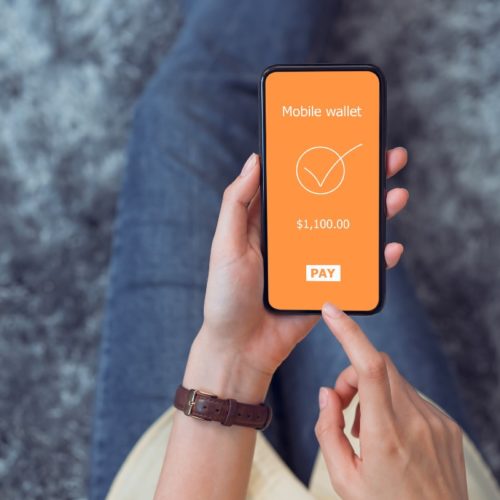Sandy just went to Barnes and Noble to buy some books for class.
Unfortunately, the check she just deposited from her side hustle hasn’t cleared yet. So when she paid for her books, she spent more than what she had in her checking account, landing her with a hefty $35 overdraft fee.
If only Sandy had a checking account buffer to protect her account, she’d be in the clear.
What exactly is a checking account buffer, and how can it help you on your financial journey?
or, skip straight to 'How to Set Up a Checking Account Buffer'.
What is a Checking Account Buffer?
Simply put, a checking account buffer is a reserve fund meant to cover small emergency situations.
The basic idea is to keep a certain amount of money in your checking account or separate savings account linked to checking. That way, if you buy something on a debit card and overdraw your account, you’ll be protected by this buffer.
As long as you maintain minimum balance requirements, your next purchase won’t push your checking account into the red.
Is a Buffer an Emergency Fund?
A checking account buffer is similar to an emergency fund… with some important differences.
The point of an emergency fund is to be able to cover the costs associated with unforeseen expenses—losing your job, getting into a car accident, or racking up expensive healthcare bills.
The trick is to have at least six months’ worth of living expenses set aside at all times. That way, you’ll have enough time to figure out your next move.
A checking account buffer is basically a smaller emergency fund. If you have $10,000 set aside in an emergency fund, you may only need $500 as a checking account buffer. The rest can be stashed in a high yield savings account and only accessed when you absolutely need it.
Why Do You Need a Checking Account Buffer?
Maintaining a checking account buffer won’t supercharge your net worth. But it will allow you to enjoy a number of benefits.
Avoiding overdraft fees
Consistently overdrawing your account can bring about negative consequences.
Fees can add up… and quickly. Banks usually forgive first-time overdraft offenders. But if it happens repeatedly, they’ll make you pay. Not cool!
What’s more, a bank may shut down your account and report you to a debit bureau if you consistently overdraft. Not only would this be a massive inconvenience in the near term, but it could also make it more challenging to open accounts in the future.
Unless that sounds like your idea of a good time, it’s always better to have built-in protection to prevent this from happening.
Covering unexpected expenses
Even the most dedicated budgets can face unexpected situations that require heftier payments from time to time.
You may be out to eat with a group that decides to split a large bill. Or, you may need to take an Uber or Lyft across town late at night and have to pay a lot of money in surge pricing to get to your destination.
In other words: life happens. That’s why it’s always better to be prepared with a checking account buffer. Having extra money in your account can be a tremendous benefit.
Preventing complications from direct deposit delays
In a perfect world, employers would always pay on time. Ours isn’t a perfect world.
Sometimes payday falls on a weekend or bank holiday. Or, your side hustle doesn’t pay on time.
By setting up a checking account buffer, you can protect yourself when money doesn’t come through and prevent yourself from running into financial trouble. You get the peace of mind that comes with knowing you won’t get hit by that exorbitant overdraft fee—ever—so long as you maintain that minimum balance.
What is a Good Checking Account Buffer?
Every financial consumer is different! So a good buffer for you largely depends on your lifestyle, spending habits, and how much you have in the bank.
Imagine Toni is fresh out of college and just starting to work. Toni’s checking account buffer could be $500, which is enough to cover daily expenses between paychecks.
Sam, on the other hand, has been working for ten years and is more financially established. Sam has much more money in the bank than Toni, and she likes to keep at least $3,000 in her checking account or linked savings account at all times.
How to Set up a Checking Account Buffer
Setting up a checking account buffer may sound complicated. Here’s a disclaimer you might be happy to hear: It’s actually not that hard!
Here’s how.
- Form a budget
- Decide how big your buffer should be
- Pick your bank account
- Transfer funds
- Monitor your account
1. Form a budget
First, take a hard look at your budget and get a sense of how much you’re spending on a monthly basis.
For help with this exercise, check out You Need a Budget (YNAB) or Personal Capital. Both of these services are helpful for budgeting purposes.
Identify the total amount you’re bringing in compared to what you’re spending on average. Then, look to cut back on areas of waste. If you spent a ton of money eating out at restaurants last month, you might want to cook more meals at home.
2. Decide how big your buffer should be
Next, take a look at your available funds and determine how much you need to set aside as a buffer.
Remember that this money is for savings, not spending freely.
This doesn’t mean your spending budget will go up. Just think of it as setting the money aside to protect yourself in case you need it.
3. Pick your bank account
Figure out the bank and account that makes sense for this type of fund.
Talk to your bank or credit union and ask if they can link your checking account to a savings account to protect you in the event you accidentally overdraw your account.
Otherwise, you may be able to have better luck with a money market account, which could be a win-win, potentially landing you a better interest rate.
Learn More: Best Online Checking Accounts of 2025
4. Transfer funds
Once you have your account set up, transfer money into the account.
If you’re keeping money in your checking account, make sure to keep careful tabs on your daily spending so that you don’t start tapping into the buffer on a daily basis.
If you have $1,000 in an account and put $2,000 in for security, keep spending as though your budget is only $1,000. Don’t start overspending just because you have more money in your account.
5. Monitor your account
Keep a running tab of your checking account balance. That way, there will never be any question about how much money you have on hand. You should be able to rattle off your checking account balance to the dollar amount without having to look at the account.
Set up automatic alerts for all transactions so that you can be aware of any changes taking place on a daily basis.
The key to managing a checking account is to stay on top of it.
Tips for Managing Your Checking Account Buffer
Keep the following strategies in mind as you begin maintaining your checking account buffer.
Start a side hustle
The best way to manage your buffer is to flood your bank account with money. The more money you bring in, the less stressful managing money becomes.
There are many ways to earn extra money in addition to your full-time job. For example, you can get paid to drive for Uber and Lyft, deliver groceries via Instacart, or babysit for friends and family members.
Some people have one side hustle, while others have several smaller side gigs they use. There’s really no end to the number of gigs you can pick up in today’s digital economy.
Learn More:
Revisit your budget from time to time
Budgets can change overnight. You may bring in more income or have different expenses pop up from time to time.
That being the case, budgets should always be fluid and changing depending on your personal financial situation. If your budget hasn’t moved in a few months or years, it’s time to take a fresh look and update it.
Learn More:
Make a buffer for your buffer
One strategy for managing your checking account is to have a green, yellow, and red zone.
The green zone should be your normal daily account balance under optimal conditions. The middle yellow zone should be a second-tier you have to dip into when you spend more than your regular balance affords.
The third tier should be your buffer zone: the last stop before you have to dip into savings to make a payment.
Imagine you have $3,000 in your checking account. You could break this down into a green zone ($3,000 to $2,000), yellow ($2,000 to $1,000), and red ($1,000 or below).
Frequently Asked Questions
How can I improve my cash flow?
Living paycheck to paycheck is neither fun nor healthy. Zero out of five stars! Do not recommend!
If you’re in this situation, it’s a good idea to save some money so you’re not scrounging for pennies at the end of the month. This is necessary for paying your bills on time, avoiding bank fees, and preventing excessive credit card debt, among other things.
To improve your cash flow, pick up a side gig. You may also want to consider asking your employer for a raise if you haven’t done so recently. Make sure you’re getting adequately compensated for your job and consider leaving if your employer doesn’t pay you a fair wage.
What’s the best way to save money?
The best way to save money is to form a budget, track where your cash is going each month, and cut back on unnecessary expenses.
If you’re spending hundreds of dollars a month on clothes, it might be time to ask yourself whether your wardrobe really needs more new threads.
When you’ve saved up money, you might want to stack it in a high-yield savings account (HYSA), which can be a buffer to your checking account buffer if you link them together.
Remember: there’s a difference between saving and investing. While a savings account protects your money, an investment account grows your funds. Investing is riskier but comes with a greater potential for reward.
Is all debt bad?
Debt can actually be beneficial in some ways. Taking out a loan or using credit cards and paying them off can help build credit. And taking out debt in the form of a mortgage can help secure a house with low monthly payments. Similarly, student loans can help you accelerate your career.
What you want to avoid is excessive credit card debt with heavy monthly interest rates. Whatever you do, stop racking up charges on credit cards and make sure you always pay your credit card balance in full every month.
The last thing you want is to end up in a never-ending spiral of credit card debt.
The Bottom Line
If you’re worried about having enough money on hand to cover monthly expenses and meet payment due dates, then you need a checking account buffer. It’s that simple.
Setting up a buffer can improve your financial situation and help you reach your goals. It can prevent you from putting money on credit cards and paying interest when you keep a running balance month to month.
Think of your checking account buffer as a mini emergency fund—something that will help you sharpen your money management skills.
At the end of the day, everyone should have at least one or two emergency savings accounts with extra cash on hand. That way, we’ll all be able to roll with whatever financial punches come our way.






No comments yet. Add your own